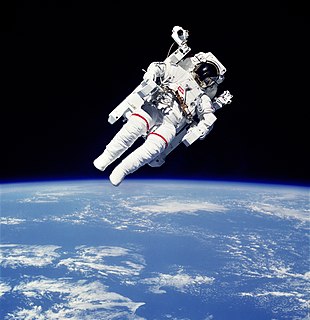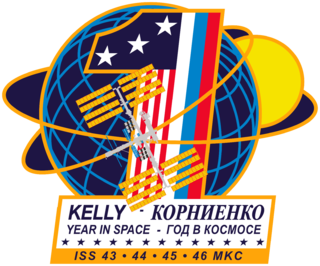Related Research Articles

An astronaut is a person trained, equipped, and deployed by a human spaceflight program to serve as a commander or crew member aboard a spacecraft. Although generally reserved for professional space travelers, the term is sometimes applied to anyone who travels into space, including scientists, politicians, journalists, and tourists.

Human spaceflight is spaceflight with a crew or passengers aboard a spacecraft, often with the spacecraft being operated directly by the onboard human crew. Spacecraft can also be remotely operated from ground stations on Earth, or autonomously, without any direct human involvement. People trained for spaceflight are called astronauts, cosmonauts (Russian), or taikonauts (Chinese); and non-professionals are referred to as spaceflight participants or spacefarers.

A space station is a spacecraft capable of supporting a human crew in orbit for an extended period of time, and is therefore a type of space habitat. It lacks major propulsion or landing systems. An orbital station or an orbital space station is an artificial satellite. Stations must have docking ports to allow other spacecraft to dock to transfer crew and supplies. The purpose of maintaining an orbital outpost varies depending on the program. Space stations have most often been launched for scientific purposes, but military launches have also occurred.
Human spaceflight programs have been conducted, started, or planned by multiple countries and companies. Until the 21st century, human spaceflight programs were sponsored exclusively by governments, through either the military or civilian space agencies. With the launch of the privately funded SpaceShipOne in 2004, a new category of human spaceflight programs – commercial human spaceflight – arrived. As of July 2021, three countries and one private company (SpaceX) have launched humans to Earth orbit, and two private companies have launched humans on a suborbital trajectory. The criteria for what constitutes human spaceflight vary. The Fédération Aéronautique Internationale defines spaceflight as any flight over 100 kilometers (62 mi). In the United States professional, military, and commercial astronauts who travel above an altitude of 80 kilometers (50 mi) are awarded the United States Astronaut Badge. This article follows the FAI definition of spaceflight.

The term micro-g environment is more or less synonymous with the terms weightlessness and zero-g, but with an emphasis on the fact that g-forces are never exactly zero—just very small. The symbol for microgravity, μg, was used on the insignias of Space Shuttle flights STS-87 and STS-107, because these flights were devoted to microgravity research in low Earth orbit.

A reduced-gravity aircraft is a type of fixed-wing aircraft that provides brief near-weightless environments for training astronauts, conducting research and making gravity-free movie shots.

Artificial gravity is the creation of an inertial force that mimics the effects of a gravitational force, usually by rotation. Artificial gravity, or rotational gravity, is thus the appearance of a centrifugal force in a rotating frame of reference, as opposed to the force experienced in linear acceleration, which by the equivalence principle is indistinguishable from gravity. In a more general sense, "artificial gravity" may also refer to the effect of linear acceleration, e.g. by means of a rocket engine.

Venturing into the environment of space can have negative effects on the human body. Significant adverse effects of long-term weightlessness include muscle atrophy and deterioration of the skeleton. Other significant effects include a slowing of cardiovascular system functions, decreased production of red blood cells, balance disorders, eyesight disorders and changes in the immune system. Additional symptoms include fluid redistribution, loss of body mass, nasal congestion, sleep disturbance, and excess flatulence. Overall, NASA refers to the various deleterious effects of spaceflight on the human body by the acronym RIDGE.
Spaceflight osteopenia refers to the characteristic bone loss that occurs during spaceflight. Astronauts lose an average of more than 1% bone mass per month spent in space. There is concern that during long-duration flights, excessive bone loss and the associated increase in serum calcium ion levels will interfere with execution of mission tasks and result in irreversible skeletal damage.

A space toilet or zero-gravity toilet is a toilet that can be used in a weightless environment. In the absence of weight, the collection and retention of liquid and solid waste is directed by use of airflow. Since the air used to direct the waste is returned to the cabin, it is filtered beforehand to control odour and cleanse bacteria. In older systems, wastewater is vented into space, and any solids are compressed and stored for removal upon landing. More modern systems expose solid waste to vacuum pressures to kill bacteria, which prevents odor problems and kills pathogens.

Space medicine is the practice of medicine on astronauts in outer space whereas astronautical hygiene is the application of science and technology to the prevention or control of exposure to the hazards that may cause astronaut ill health. Both these sciences work together to ensure that astronauts work in a safe environment. The main objective is to discover how well and for how long people can survive the extreme conditions in space, and how fast they can adapt to the Earth's environment after returning from their voyage. Medical consequences such as possible blindness and bone loss have been associated with human spaceflight.

Weightlessness is the complete or near-complete absence of the sensation of weight. This is also termed zero-G, although the more correct term is "zero G-force". It occurs in the absence of any contact forces upon objects including the human body.

The ADELI Suit is derived from a suit originally designed for the Soviet space program in the late 1960s that was first tested in 1971. The purpose then was to give the cosmonauts in space a way to counter the effects of long-term weightlessness on the body. The ADELI Suit is currently used to treat children with physical disabilities resulting from cerebral palsy, other neurological conditions originating from brain damage or spinal cord injury.

The ISS year-long mission was an 11-month-long scientific research project aboard the International Space Station, which studied the health effects of long-term spaceflight. Astronaut Scott Kelly and Cosmonaut Mikhail Kornienko spent 340 days in space, with scientists performing medical experiments. Kelly and Kornienko launched on 27 March 2015 on Soyuz TMA-16M along with Gennady Padalka. The mission encompassed Expeditions 43, 44, 45 and 46. The pair safely landed in Kazakhstan on March 2, 2016, returning aboard Soyuz TMA-18M with Sergey Volkov. The mission supported the NASA Twins study, which helps shed light on the health effects of long-duration spaceflight, which is of interest for Mars missions especially.

Locomotion in space includes any variety of actions or methods used to move one's body through an environment with microgravity conditions. Locomotion in these conditions is different from locomotion in Earth's gravity. There are many factors that contribute to these differences, and they are crucial when researching long-term survival of humans in space.

A Mars suit or Mars space suit is a space suit for EVAs on the planet Mars. Compared to a suit designed for space-walking in the near vacuum of low Earth orbit, Mars suits have a greater focus on actual walking and a need for abrasion resistance. Mars' surface gravity is 37.8% of Earth's, approximately 2.3 times that of the Moon, so weight is a significant concern, but there are fewer thermal demands compared to open space. At the surface the suits would contend with the atmosphere of Mars, which has a pressure of about 0.6 to 1 kilopascal. On the surface, radiation exposure is a concern, especially solar flare events, which can dramatically increase the amount of radiation over a short time.
Alcoholic drinks are generally disallowed in spaceflight, but space agencies have previously allowed its consumption. NASA has been stricter about alcohol consumption than the Roscosmos, both according to regulations and in practice. Astronauts and cosmonauts are restricted from being intoxicated at launch. Despite restrictions on consumption, there have been experiments in making and keeping alcoholic drinks in space.
References
- 1 2 Jason Palmer (2010-11-04). "Gravity suit mimics Earth's pull for astronauts". BBC News. Retrieved 2014-03-17.
- ↑ Liat Clark (2014-01-27). "Space skinsuit could stop astronauts developing back problems" . Retrieved 2014-03-17.
- 1 2 "Penguin". Encyclopedia Astronautica. Archived from the original on 2016-03-23. Retrieved 2016-04-04.
- ↑ D.S.F. Portree (March 1995). "Mir Hardware Heritage" (PDF). NASA. p. 69. Archived from the original (PDF) on 2016-04-03. Retrieved 2016-04-04.
- ↑ Smitha Mundasad (2014-03-17). "Skin-tight space suits 'support astronauts' bones'". BBC News. Retrieved 2014-03-17.